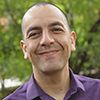Shane Doyle links Montana tribes,
international researchers over prehistoric boy
http://www.montana.edu/news/12421/shane-doyle-links-montana-tribes-international-researchers-over-prehistoric-boy
by Evelyn Boswell, MSU News Service
February 12, 2014
BOZEMAN – On a beautiful fall day, Shane Doyle sang a somber song for a young boy who was buried some 12,600 years ago south of present-day Wilsall.
“I wanted to honor the spirit of the boy. There was a disturbance there. I felt like there needed to be some healing,” said the enrolled member of the Crow tribe and an instructor in the Native American Studies program at Montana State University.
Sarah Anzick said the honor song Doyle sang last September was beautiful, touching and a fitting tribute for the child she has known about since she was two years old, approximately the same age the boy was when he died from unknown causes. Anzick’s parents own the property where his skull and bone fragments were discovered in 1968. His are among the oldest human remains found in North America and the only Late Pleistocene human from a Clovis burial site.
Doyle’s song also helped confirm that he was the right person to serve as liaison between Montana tribes and an international team of scientists who conducted a genetic study that led to major findings that will be published in the Feb. 13 issue of the journal, Nature, said Anzick, a co-author and molecular biologist on the project.
“We were so fortunate that he was willing to join our team and facilitate the connections with the Native American communities,” Anzick said. “This is something I had tried to do many years ago, but was unsuccessful. “
A press release from Nature said the team of scientists reported the first complete genome sequence of an ancient North American human – the boy whose skeletal fragments were discovered near Wilsall, in association with dozens of ochre-covered stone tools. The scientists found that the boy belonged to a population from which many contemporary Native Americans descended – including Doyle -- and is closely related to all indigenous American populations.
 |
Evidence of the Past: A Map and Status of Ancient Remains.
For burial specifics - go to link here |
The study showed very early division within Native Americans, but all groups from which scientists have DNA show a close relationship to the Anzick child. The scientists said their study also presents one of the strongest challenges so far to the hypothesis about the origin of the Clovis culture. It was generally believed that the Clovis people originally came from Asia and were directly related to contemporary Native Americans, but an alternative theory had suggested that Clovis predecessors emigrated from southwestern Europe. Clovis, with its distinctive stone tools, is the oldest widespread archaeological complex in North America. It dates to around 12,600-13,000 years ago.
Doyle, who is one of 42 co-authors of the Nature paper, said he isn’t a geneticist, but he has experience bringing MSU and the Montana tribes together. He, for one, is the link between MSU nursing students and tribal clinics. Doyle grew up on the Crow Indian Reservation and earned his bachelor’s, master’s and doctoral degrees at MSU. For his doctorate in education, he studied the Absaroka Agency archaeological excavation, specifically how tribes and archaeologists can best collaborate. He currently teaches Native American belief and philosophy at MSU. He has been a member of the Bobcat Singers drum group since 1989.
He first met Eske Willerslev, principal investigator for the Anzick project, in September when Willerslev came to Montana, Doyle said. Willerslev is a world-renowned ancient DNA researcher at the Center for GeoGenetics at the University of Copenhagen in Denmark. Willerslev became involved in the Montana study through Anzick and archaeologist Mike Waters, director of the Center for the Study of the First Americans at Texas A & M University. Waters’ predecessor conducted research on Kennewick Man, a prehistoric man found on the banks of the Columbia River in 1996.
Besides singing a Northern Cheyenne honor song at the boy’s burial site, Doyle drove Willerslev to the Crow, Northern Cheyenne, Blackfeet and Flathead Indian Reservations to meet with the tribal historic preservation officers and other Native Americans to explain the genetic study and consult with the tribes about the boy’s reburial. Doyle said he would have taken Willerslev to more reservations, but they didn’t have enough time.
Willerslev said he understands the many feelings that are involved when scientists study ancient human remains. He understands why members of the tribes hold strong feelings about the past.
From his Montana trip, he said, “I learned that all the cultural representatives I met in the tribes of Montana are clever peoples with a deep cultural and historical insight, and I was very well received by them all. A great experience. Shane guided me through this process. Without him, I would have been lost.”
In December, Doyle flew to Denmark where he spoke to Willerslev’s graduate students and met Waters for the first time.
Earlier this week, as the Nature publication neared, Doyle, Willerslev, Waters and Anzick spoke at two Montana press conferences about their genetic findings, plans for a respectful reburial, the project’s history, and implications for archaeology in the future. The first press conference was held Feb. 11 at Little Big Horn College in Crow Agency. The second was held Feb. 12 at the Montana Historical Society in Helena, where all the artifacts from the Anzick site will be displayed.
“This is truly a state treasure to be shared and enjoyed by all,” Anzick said.
Doyle said it’s obvious from the large number of artifacts that were found with the boy that he was loved.
Livingston archaeologist Larry Lahren, an MSU graduate who has studied the Anzick site for 40 years, said in a recent lecture at MSU’s Museum of the Rockies, that “You would be overwhelmed to look at the collection to see the size and quantity of the materials.”
He added that the site south of Wilsall wasn’t a cache, but definitely an ancient burial site. In addition to the skull and bone fragments that yielded significant genetic information were the remains of another boy. That boy was six to eight years old when he died. He was buried about 9,000 years ago.
Doyle, the father of five children from ages 1 through 9, said he feels for the anguished parents who lost their sons so long ago. He added that normal parental feelings and Native American traditions indicate that it’s time to rebury the boy whose genome is discussed in Nature.
The reburial will occur as soon as this spring and will be as close as possible to the original burial site, Doyle said. One of the major players will likely be Larson Medicinehorse of Crow Agency, who was involved in the reburial of Chief Pretty Eagle almost 20 years ago.
“You feel like it’s morally the right thing to do. It’s the reason why I agreed to help,” Doyle said of the upcoming reburial.
Willerslev, Waters and Anzick agreed.
“As a scientist, I have mixed feelings as the remains may well still hold information to be gained,” Willerslev said. “However, I do respect this wish from the tribes, and I know they feel deeply about why it has to take place. Had it been my child, I would have wished it to be reburied too. As scientists, we have a lot to learn from the tribes.”
Anzick said, “I feel a moral obligation for the reburial and yes, as technology advances, we can always learn more. Had these remains been reburied just 10 years ago, they wouldn’t have revealed what we know today, and I’m certain we can learn even more.
“However, out of respect for the Native American communities and the parents of this child, a reburial is an important part of the equation,” Anzick said. “It is my hope through open communications, dialogue and Native American involvement, we can collaborate toward a working model which leads ultimately to a respectful reburial.”
Waters said, “This was a prehistoric tragedy. Someone lost their child. They lovingly buried this child with artifacts and red ochre. Like Shane pointed out, they would have been valuable and important things to people who were hunters and gathers. They clearly showed the emotions of these early people.
“I appreciate the way Shane has been doing an outstanding job of shepherding us through the process of talking to various Native American groups and finding the path to the proper reburial of these remains,” Waters said.
Doyle said he is impressed with all the scientists on the project.
“They didn’t have to bring me in,” he said.
He added that his life hasn’t been the same since he joined their team. Not only has it led to new interactions and opportunities for future collaborations, but the genetic findings proved what he has always believed.
“It’s one thing to believe and sense that your people have been here for thousands and thousands of years,” Doyle explained. “It’s another thing to have scientific evidence and proof that those paleo-Indians were us and we are them.”
The genetic study led to a rush of profound emotions, Doyle said. It made him proud of his ancestors and the way they cared for the land. It gave him new appreciation for family. He was shocked when he realized that the land where the boy was buried is part of the area included in an 1851 treaty signed by his great-great-great-great-grandfather Mountain Tail.
“All my family comes from this place and so did this little boy,” Doyle said. “We are not only connected by geography, but by blood. It was so moving for me.”
Evelyn Boswell, (406) 994-5135 or evelynb@montana.edu
















